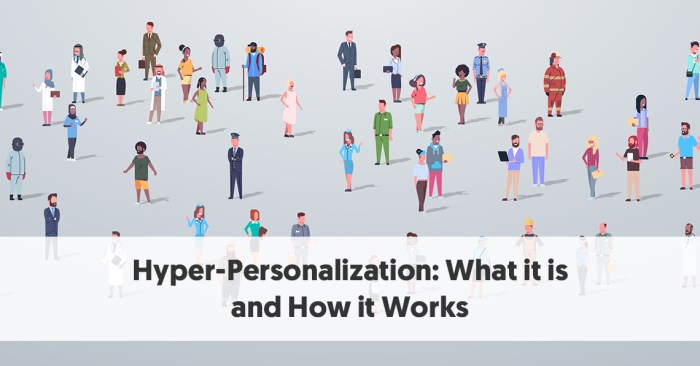Defining Hyper-Personalization in CRM and CX
How Hyper-Personalization is Transforming CRM and CX – Hyper-personalization is an advanced form of personalization that leverages artificial intelligence (AI), machine learning (ML), and customer data to create highly customized experiences for each individual customer.
In the context of CRM and CX, hyper-personalization involves tailoring interactions, communications, and experiences to meet the specific needs, preferences, and behaviors of each customer. This can include:
Examples of Hyper-Personalized Experiences
- Personalized email campaigns with tailored content based on customer purchase history, demographics, and preferences.
- Real-time recommendations on a website or mobile app based on a customer’s browsing behavior and past purchases.
- Personalized customer service interactions that take into account a customer’s previous interactions and preferences.
Benefits of Hyper-Personalization in CRM and CX: How Hyper-Personalization Is Transforming CRM And CX

Hyper-personalization in CRM and CX brings numerous advantages to businesses. By tailoring experiences to individual customer preferences and behaviors, companies can foster stronger relationships, increase satisfaction, and drive loyalty.
Studies have consistently demonstrated the positive impact of hyper-personalization. For instance, a report by McKinsey & Company found that personalized marketing campaigns can generate up to 40% higher conversion rates than generic campaigns. Additionally, a study by Accenture revealed that 91% of consumers are more likely to make purchases from brands that provide personalized experiences.
Increased Customer Satisfaction and Loyalty
- Personalized experiences create a sense of value and appreciation, fostering customer satisfaction.
- By understanding customer preferences and tailoring interactions accordingly, businesses can build trust and loyalty.
- Hyper-personalized communication, such as personalized emails or product recommendations, demonstrates that companies genuinely care about their customers’ needs.
Challenges of Implementing Hyper-Personalization in CRM and CX

Implementing hyper-personalization in CRM and CX presents several challenges for businesses. These include:
- Data Privacy Concerns:Hyper-personalization relies on collecting and analyzing vast amounts of customer data. Businesses must ensure they comply with data privacy regulations and address customer concerns about data usage.
- Data Quality and Integration:Hyper-personalization requires high-quality, integrated data from multiple sources. Businesses may face challenges in collecting, cleaning, and integrating data from different systems.
- Technical Complexity:Implementing hyper-personalization requires advanced technical capabilities, such as data analytics, machine learning, and personalization engines. Businesses may need to invest in technology and expertise to overcome these challenges.
- Scalability:Hyper-personalization can be challenging to scale to large customer bases. Businesses need to ensure their systems can handle the volume of data and provide personalized experiences for all customers.
- Cost:Implementing and maintaining hyper-personalization can be expensive, requiring investments in technology, data analytics, and skilled personnel.
Overcoming Challenges, How Hyper-Personalization is Transforming CRM and CX
Businesses can overcome these challenges by:
- Prioritizing Data Privacy:Businesses should develop clear data privacy policies, obtain customer consent, and implement robust data security measures.
- Investing in Data Management:Businesses should invest in data management tools and processes to ensure data quality and integration.
- Partnering with Technology Providers:Businesses can partner with technology providers who offer solutions for data analytics, personalization, and scalability.
- Starting Small:Businesses can start with small-scale hyper-personalization initiatives and gradually expand as they gain experience and overcome challenges.
- Measuring ROI:Businesses should track key metrics to measure the return on investment from hyper-personalization and identify areas for improvement.
Use Cases of Hyper-Personalization in CRM and CX
Hyper-personalization is transforming CRM and CX by enabling businesses to create highly personalized experiences for each customer. This can lead to increased customer satisfaction, loyalty, and revenue. Here are a few real-world examples of how businesses are using hyper-personalization to improve their CRM and CX:
E-commerce
- Amazon uses hyper-personalization to recommend products to customers based on their browsing history, purchase history, and demographics. This helps customers find the products they’re most interested in and makes the shopping experience more efficient and enjoyable.
- Netflix uses hyper-personalization to recommend movies and TV shows to users based on their viewing history and preferences. This helps users discover new content that they’re likely to enjoy and makes the streaming experience more enjoyable.
Financial services
- Banks use hyper-personalization to provide tailored financial advice and recommendations to customers. This helps customers make informed financial decisions and achieve their financial goals.
- Insurance companies use hyper-personalization to offer customized insurance policies and discounts to customers. This helps customers get the coverage they need at a price they can afford.
Healthcare
- Hospitals use hyper-personalization to provide personalized care plans and treatment options to patients. This helps patients get the best possible care and improve their health outcomes.
- Pharmaceutical companies use hyper-personalization to develop targeted marketing campaigns and provide personalized drug information to patients. This helps patients make informed decisions about their healthcare and get the medications they need.
These are just a few examples of how businesses are using hyper-personalization to improve their CRM and CX. As technology continues to evolve, we can expect to see even more innovative and effective uses of hyper-personalization in the future.
Future Trends in Hyper-Personalization for CRM and CX

Hyper-personalization is a rapidly evolving field, and several emerging trends will shape its future. Artificial intelligence (AI) and machine learning (ML) are two of the most important trends, as they can be used to automate many of the tasks involved in hyper-personalization.
For example, AI can be used to analyze customer data to identify patterns and trends, and ML can be used to create personalized recommendations and offers.
Another important trend is the increasing use of omnichannel marketing. Omnichannel marketing is the practice of delivering a consistent customer experience across all channels, such as email, social media, and mobile. Hyper-personalization can be used to create omnichannel experiences that are tailored to each customer’s individual needs and preferences.
Use of AI and ML
AI and ML are already being used in a variety of ways to personalize CRM and CX. For example, AI can be used to:
- Identify customer needs and preferences
- Create personalized recommendations and offers
- Automate customer service interactions
- Detect and prevent customer churn
ML can be used to:
- Learn from customer data to improve personalization efforts
- Identify patterns and trends in customer behavior
- Create predictive models to anticipate customer needs
Omnichannel Personalization
Omnichannel personalization is essential for delivering a consistent customer experience across all channels. Hyper-personalization can be used to create omnichannel experiences that are tailored to each customer’s individual needs and preferences. For example, a customer who has previously purchased a product from a company’s website might receive a personalized email offer for a related product.
Or, a customer who has had a positive experience with a company’s customer service team might receive a personalized thank-you note.
Hyper-personalization is a powerful tool that can be used to improve CRM and CX. By leveraging AI, ML, and omnichannel marketing, businesses can create personalized experiences that are tailored to each customer’s individual needs and preferences.
FAQ Insights
What is hyper-personalization?
Hyper-personalization is a data-driven approach to tailoring customer experiences by leveraging individual customer data to create highly relevant and personalized interactions.
What are the benefits of hyper-personalization?
Hyper-personalization offers numerous benefits, including increased customer satisfaction, enhanced loyalty, improved conversion rates, and optimized marketing campaigns.
What are the challenges of implementing hyper-personalization?
Implementing hyper-personalization can pose challenges, such as data privacy concerns, technological limitations, and the need for a skilled workforce.